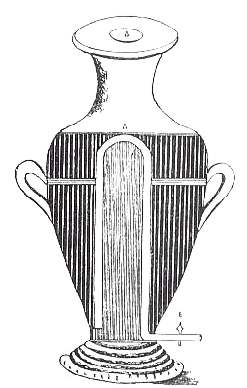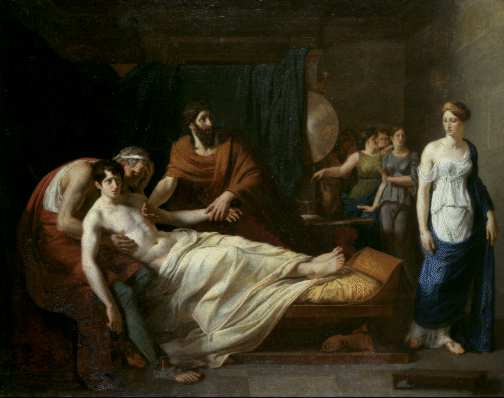.

Herophilos (or Herophilus) of Chalcedon (Ηρόφιλος ο Χαλκηδόνιος) (about 280 BC ( ille anatomicorum coryphaeus according to Vesalius), most important contribution to medicine was his development of the theory of the diagnostic value of the pulse. Although the pulse is referred earlier (for example by Aristotle in Animals 521a5f), it was the teacher of Herophilos, Praxagoras of Cos, who restricted the pulse to a distinct group of vessels and held that it could be used as an indicator of disease. Herophilos made further corrections on several points, maintaining that the pulse is not an innate faculty of the arteries, but one they derive from the heart, and distinguishing the pulse not merely quantitatively, but also qualitatively from palpitations, tremors and spasms, which are muscular in origin. He provided some interesting names for various types of pulses (such as dorkadizon, “leaping like a gazelle,” or myrmekizon, “crawling like an ant,”).
Following a suggestion of the Coan physician Praxagoras, he included the taking of the pulse in diagnosis, and used a water clock to measure its frequency Durant

The waterclock of Herophilos (Mitteilung zur Geschichte der Medizin)
Interesting are reports that physicians used portable waterclocks to measure the pulse of patients. (Peters, Arno: Synchronoptische Weltgeschichte. Grundband, München, 1970 in German)
Erasistratos (or Erasistratus) of Ioulis (Ερασίστρατος ο Κείος ) (about 325 - 250 BC) , from the Iouliad city-state on Keos (or Ceos) island. Son of Kretoxene, the sister of Medios the doctor, and of Kleombrotos. Erasistratos studied in Athens. He worked as physician in Alexandria and described the brain more accurately than Herophilos. He distinguished the cerebrum from the cerebellum, and he determined that the brain was the originating point for all nerves. He distinguished sensory from motor nerves and he was the first to dispel the notion that nerves are hollow and filled with pneuma (air); but are solid, consisting of marrow of the spinal kind. In his account of the heart and its function, he distinguished between pulmonary and systemic circulation and describes the bicuspid and tricuspid valves. He is buried by Mount Mykale, opposite Samos. He wrote 9 books on medicine.
He had some notion of basal metabolism, for he devised a crude respiration calorimeter. ... He discarded the humoral theory of Hippocrates, which Herophilus had retained. He conceived the art of medicine as prevention through hygiene rather than as cure through therapy; he opposed the frequent use of drugs and bloodletting, and relied upon diet, bathing and exercise Durant
Famous is Erasistratos discovery of the “illness” of Antiochus, the son of the King of Syria Seleucus I Nicator.

Erasistratos examines the pulse of Antiochus I Soter, on the right side Stratonice of Syria
Sometimes illness has a mental rather a physical cause. Seleucus calls Erasistratos to help his son Antiochus. Other Physicians are not able to find what he has. While examining the patient Erasistratos recognizes that the pulse of Antiochus gets faster when the beautiful Stratonice, the young wife of Seleucus, enters the room. Erasistratos recognizes that the young Antiochus loves his stepmother and that this is the reason of his illness.
Or as Plutarch says:
For Antiochus, it appears, had fallen passionately in love with Stratonice, the young queen, who had already made Seleucus the father of a son. He struggled very hard with the beginning of this passion, and at last, resolving with himself that his desires were wholly unlawful, his malady past all cure, and his powers of reason too feeble to act, he determined on death, and thought to bring his life slowly to extinction by neglecting his person and refusing nourishment, under the pretence of being ill. Erasistratus, the physician who attended him, quickly perceived that love was his distemper, but the difficulty was to discover the object. He therefore waited continually in his chamber, and when any of the beauties of the court made their visit to the sick prince, he observed the emotions and alterations in the countenance of Antiochus, and watched for the changes which he knew to be indicative of the inward passions and inclinations of the soul. He took notice that the presence of other women produced no effect upon him; but when Stratonice came, as she often did, alone, or in company with Seleucus, to see him, he observed in him all Sappho's famous symptoms,- his voice faltered, his face flushed up, his eyes glanced stealthily, a sudden sweat broke out on his skin, the beatings of his heart were irregular and violent, and, unable to support the excess of his passion, he would sink into a state of faintness, prostration, and pallor.
Erasistratus, reasoning upon these symptoms, and, upon the probabilities of things, considering that the king's son would hardly, if the object of his passion had been any other, have persisted to death rather than reveal it, felt, however, the difficulty of making a discovery of this nature to Seleucus. But, trusting to the tenderness of Seleucus for the young man, he put on all the assurances he could, and at last, on some opportunity, spoke out and told him the malady was love, a love impossible to gratify or relieve. The king was extremely surprised, and asked, "Why impossible to relieve?" "The fact is," replied Erasistratus, "he is in love with my wife." "How!" said Seleusus, "and will our friend Erasistratus refuse to bestow his wife upon my son and only successor, when there is no other way to save his life?" "You," replied Erasistratus, "who are his father, would not do so, if he were in love with Stratonice." "Ah, my friend," answered Seleucus, "would to heaven any means, human or divine, could but convert his present passion to that; it would be well for me to part not only with Stratonice, but with my empire, to save Antiochus." This he said with the greatest passion, shedding tears as he spoke; upon which Erasistratus, taking him by the hand, replied, "In that case, you have no need of Erasistratus; for you, who are the husband, the father, and the king, are the proper physician for your own family." Seleucus, accordingly, summoning a general assembly of his people, declared to them, that he had resolved to make Antiochus king, and Stratonice queen, of all the provinces of Upper Asia, uniting them in marriage; telling them, that he thought he had sufficient power over the prince's will that he should find in him no repugnance to obey his commands; and for Stratonice, he hoped all his friends would endeavour to make her sensible, if she should manifest any reluctance to such a marriage, that she ought to esteem those things just and honourable which had been determined upon by the king as necessary to the general good. In this manner, we are told, was brought about the marriage of Antiochus and Stratonice.
Antiochos (or Antiochus) I Soter (reigned 281-261 BC), son of Seleukos I the successor of Alexander the Great (king of Alexander's former Asiatic territories from 305 to 281).
Antiochos was designated co-ruler from 294 or 293, so the handing on of Queen Stratonike to her stepson may have had the political purpose of cementing the succession. The story is told by Plutarch, Life of Demetrios, 38; Appian, Syrian Wars, 59-61. SUDA
A similar story we have about the Greek Physician Galen:
...but Galen's story is worth telling, and it is figured as a miniature in the manuscripts of his works. Called to see a lady he found her suffering from general malaise without any fever or increased action of the pulse. He saw at once that her trouble was mental and, like a wise physician, engaged her in general conversation. Quite possibly he knew her story, for the name of a certain actor, Pylades, was mentioned, and he noticed that her pulse at once increased in rapidity and became irregular. On the next day he arranged that the name of another actor, Morphus, should be mentioned, and on the third day the experiment was repeated but without effect. Then on the fourth evening it was again mentioned that Pylades was dancing, and the pulse quickened and became irregular, so he concluded that she was in love with Pylades. William Osler, The Evolution of Modern Medicine
Herophilus, ille anatomicorum coryphaeus, as Vesalius calls him, was a pupil of Praxagoras, and his name is still in everyday use by medical students, attached to the torcular Herophili. Anatomy practically dates from these Alexandrines, who described the valves of the heart,the duodenum, and many of the important parts of the brain; they recognized the true significance of the nerves (which before their day had been confounded with the tendons), distinguished between motor and sensory nerves, and regarded the brain as the seat of the perceptive faculties and voluntary action. Herophilus counted the pulse, using the water-clock for the purpose, and made many subtle analyses of its rate and rhythm; and, influenced by the musical theories of the period, he built up a rhythmical pulse lore which continued in medicine until recent times. He was a skilful practitioner and to him is ascribed the statement that drugs are the hands of the gods. There is a very modern flavor to his oft-quoted expression that the best physician was the man who was able to distinguish between the possible and the impossible.
Erasistratus elaborated the view of the pneuma, one form of which he believed came from the inspired air, and passed to the left side of the heart and to the arteries of the body. It was the cause of the heart-beat and the source of the innate heat of the body, and it maintained the processes of digestion and nutrition. This was the vital spirit; the animal spirit was elaborated in the brain, chiefly in the ventricles, and sent by the nerves to all parts of the body, endowing the individual with life and perception and motion. In this way a great division was made between the two functions of the body, and two sets of organs in the vascular system, the heart and arteries and abdominal organs, life was controlled by the vital spirits; on the other hand, in the nervous system were elaborated the animal spirits, controlling motion, sensation and the various special senses. These views on the vital and animal spirits held unquestioned sway until well into the eighteenth century, and we still, in a measure, express the views of the great Alexandrian when we speak of "high" or "low" spirits.
William Osler, The Evolution of Modern Medicine
Torcular Herophili (PDF)
Greek Medicine By Charles Singer
Other ancient Greek medical facts
Dioscorides
Hippocrates
Artemidorus
Dissections
Durant, The Life of Greece New York: Simon and Schuster, 1966
| Ancient Greece
Science, Technology , Medicine , Warfare, , Biographies , Life , Cities/Places/Maps , Arts , Literature , Philosophy ,Olympics, Mythology , History , Images Medieval Greece / Byzantine Empire Science, Technology, Arts, , Warfare , Literature, Biographies, Icons, History Modern Greece Cities, Islands, Regions, Fauna/Flora ,Biographies , History , Warfare, Science/Technology, Literature, Music , Arts , Film/Actors , Sport , Fashion --- |

